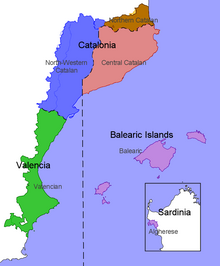Northern Catalan
This article does not cite any sources. (March 2008) |
| Northern Catalan | |
|---|---|
| rossellonès, català | |
 Street sign in Formiguera. | |
| Native to | France |
| Region | Northern Catalonia |
| Ethnicity | Catalans |
Early form | |
| Catalan alphabet | |
| Language codes | |
| ISO 639-3 | – |
| IETF | ca-FR |
 The areas of French Oriental Pyrenees where Catalan is spoken in ■ orange. | |
| The Catalan / Valencian cultural domain |
|---|
 |
Northern Catalan (Catalan: català septentrional, pronounced [kətəˈla səptəntɾiuˈnal], also known as rossellonès) is a Catalan dialect mostly spoken in Northern Catalonia, but also extending in the northeast part of Southern Catalonia in a transition zone with Central Catalan.
Like other Eastern Catalan dialects, unstressed /a/ and /e/ are realized as schwa [ə], and [u] substitutes unstressed /o/. It has only five stressed vowels, the smallest number of any Catalan dialect: /i e a o u/.
There are some instances of historic stressed /o/ that has changed to /u/: canigó > canigú.
As in the Balearic dialects, final a is not pronounced in words ending with ia if the stress is before the penultimate syllable.
Some subdialects keep the singular masculine definite article lo, as in North-Western Catalan and many varieties of Occitan.
Northern Catalan has a large body of words imported from French and Occitan. It also features some grammatical forms and structures that are typical of Occitan, such as the use of a lone post-verbal pas, rather than a lone preverbal no to express basic negation (Northern Catalan canti pas vs. Central Catalan no canto, 'I don't sing' or 'I'm not singing'); pas is also used in some other Catalan dialects for emphasis but always with no before the verb (Central Catalan no canto pas, 'I do not sing' or 'I am not singing').
Notes[]
- ^ Jump up to: a b Some Iberian scholars may alternatively classify Catalan as Iberian Romance/East Iberian.
References[]
| Wikimedia Commons has media related to Northern Catalan. |
- Catalan dialects
- Linguistic rights
- Pyrénées-Orientales
- Romance language stubs
- Catalonia stubs